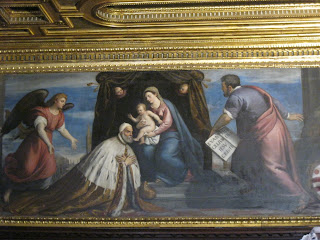On Sunday, August 21st, Gay and I went to worship at the City Church in Wittenberg. As it turns out, it was a special service in that there were two baptisms. They were the daughters of a couple with one about three or four and the other a toddler. In addition, there was a youth group at worship of about 40 youth perhaps in 5th grade. Taken together with others at worship, there seemed to be over 100.
This link is to a rather lengthy video. It contains "footage" of the interiors of the Castle Church and City Church in Wittenberg as well as video with bells before worship, prelude, and postlude at the City Church.
http://www.youtube.com/watch?v=i62aupO-XMM
This is at the beginning of the baptismal service.
After worship, we drove to Leipzig to explore some of the surroundings of J.S. Bach. We had three sites in mind. The first two were churches where Bach served. They are Thomas Church and Nicholas Church. The third site was the Bach museum.
This is a view from the chancel facing the main organ in the Thomas Church.
This stained glass is in honor of Bach in the Thomas Church.
This organ is a recent addition to Thomas Church and was built to be much like the instrument at the church when Bach served here.
This stands outside of the Thomas Church
This shot is looking toward the chancel in the Nicholas Church. This is the other main congregation at which Bach served in Leipzig.
Our final goal for Leipzig was to go through the Bach museum. It is a fine collection and one of its features is that it gives people the possibility to access a number of Bach's compositions and listen to them. It has been done in a way which is very accessible. One could spend quite a bit of time simply "surfing" from one piece to another to one type to another.

This piece of whimsy was on the first floor of the museum.
When we were done at the museum. We drove back to Wittenberg. On Monday, August 2nd, we started our trip back by driving to Frankfurt. The autobahn was fine to drive on and though some drive extremely fast, the "culture" of the road is clear and by and large, the drivers are courteous. I did not go over 135 kilometers per hour!
Our flights home went smoothly. We flew Lufthansa from Frankfurt to San Francisco and United back to Eugene.
It has been quite an experience from Israel to Italy to Germany. I have experienced much- much which has been beautiful and inspiring as well as much which has shown the darker nature of humanity. The beauty and brutality of our race seem to exist side by side.
Indeed, Luther himself had these dynamics within himself. He was a shining light of God's grace as well as someone who could express hatred towards others who did not agree with him.
It seems to me that the continuing challenge before us as individuals and as groups is to live out the grace and compassion of God. That it seems to me is neither easy nor natural. May God's Spirit continue to breathe such new life into us that we may live it out in how we treat one another.
In the days ahead, I will be working on classes and putting thoughts together as well as working in the yard, playing tennis, and enjoying being back in the U.S.
Blessings!


























































